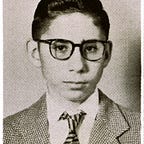From Codex To E-Readers — Non Linear Portraiture?
The codex is built for nonlinear reading — not the way a Web surfer does it, aimlessly questing from document to document, but the way a deep reader does it, navigating the network of internal connections that exists within a single rich document like a novel. Indeed, the codex isn’t just another format, it’s the one for which the novel is optimized. The contemporary novel’s dense, layered language took root and grew in the codex, and it demands the kind of navigation that only the codex provides. Imagine trying to negotiate the nested, echoing labyrinth of David Mitchell’s “Cloud Atlas” if it were transcribed onto a scroll. It couldn’t be done. God knows, there was great literature before there was the codex, and should it pass away, there will be great literature after it. But if we stop reading on paper, we should keep in mind what we’re sacrificing: that nonlinear experience, which is unique to the codex. You don’t get it from any other medium — not movies, or TV, or music or video games. The codex won out over the scroll because it did what good technologies are supposed to do: It gave readers a power they never had before, power over the flow of their own reading experience. And until I hear God personally say to me, “Boot up and read,” I won’t be giving it up. Lev Grossman, NY Times September 2, 2011
I read the article Mechanic Muse — From Scroll to Screen by Lev Grossman last night in bed in my NY Times and I was instantly amazed as how writers in the NY Times write about stuff from an angle that few of us ever imagine. This one was all about how papyrus scrolls were difficult to read (all that unrolling!) and how the codex (the book as we know it even before it was printed by Gutenberg) adopted by enterprising early Christians changed how we read. The Kindle and its variant of imitators is now going to fundamentally affect how we read. I am aware that one of the wonders of on line reading is the ability to click on hyperlinks or to look up words within the text that we might not recognize. But Grossman argues that we will be losing an important freedom. The essay left me thinking and that led to today’s blog featuring photographs I took three years ago of León, Guanajuato, Mexico-born Ivette Hernandez who posed for me for about a year and we pursued my Mexican nostalgia. In the photos here are my interpretation of La Santa Muerte who is the patron saint of drug traffickers and drug cartels in Mexico and in particular in the northern parts. I used for my shots a Mexican papier-mâché skeleton given to me by architect Abraham Rogatnick, who knowing he was dying, got rid of most of his stuff.
Mamiya RB-67 Pro-SD 90mm Kodak Plus-X These pictures were taken in b+w (two variants) and in colour slide with my Mamiya RB-67. The other (two variants here) I used a Nikon FM-2 with Kodak b+w infrared film.
A modern photographer might take all these with one high end digital camera in what is called the raw format. From that format the photographer can choose to make several versions. One might be in colour, one might be in b+w and another in b+w using an infrared plug or app that would mimic real (alas no longer made) Kodak B+w Infrared Film. The photographer might have even shot the same variants of La Santa Muerte where Hernandez has a lace cover over her head and one without it.
But I argue here (I am not sure if I am arguing that my method is the better one) that these four pictures were taken at a different point in time. Hernandez might have moved and I certainly had to move since the Mamiya and the Nikon would have forced me to move up or down, back or forward. I am pointing out that the digital photographer can make one photograph look like four different photographs but in actual fact my four photographs are unique in that they are not taken at the same precise time. The use (the making of the choice) of one film or the other, of one camera or another in many ways affects my relationship to my subject. Each camera by its size and shape affects how I hold it and how I proceed to take my pictures. I believe this is good but I have no proof that this method is “better”in the same way that Grossman’s essay in the NY Times does not prove one way or another that a codex book is better than an e-reader.
Originally published at blog.alexwaterhousehayward.com.
